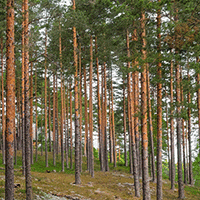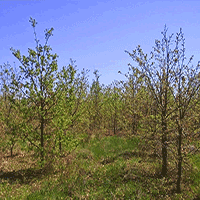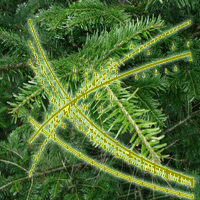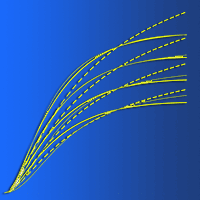
Site quality assessment of degraded Quercus frainetto stands in central Greece
Kyriaki Kitikidou (1) , Elias Milios (1), Elias Tsirekis (1), Elias Pipinis (2), Athanasios Stampoulidis (1)
iForest - Biogeosciences and Forestry, Volume 8, Issue 1, Pages 53-58 (2015)
doi: https://doi.org/10.3832/ifor1069-007
Published: May 12, 2014 - Copyright © 2015 SISEF
Research Articles
Abstract
The potential yield of a site is measured by site index, which is defined as the dominant height of a stand at a base age. A site index model for site quality assessment of Quercus frainetto (Hungarian oak) stands in central Greece was developed using a base age of 50 years. Data were collected from 39 temporary sample plots of 10 x 10 m. Linear regression models widely used in site index studies were fitted to height-age data. The adjusted coefficient of determination (R2adj), root mean square error (RMSE), bias, coefficient of determination for the prediction (R2pr) and residual plots were used for the choice of the best-fitting model. The best model was H = -0.231+0.251A-0.001A2, where H is the predicted height at age A. The guide curve method was adopted in constructing the sites curves, with the chosen model as the guide curve. Based on this curve, the study area was divided into three site quality classes (I to III), with class I representing the best and class III the poorest. Also, the presence of a Simpson’s paradox in these analyses is discussed. The results showed that a 50-year-old stand in the study area attained an average dominant height of about 11, 8 and 6 m on site quality classes I, II and III, respectively. The Hungarian oak stands of the present study can be considered very low productivity stands.
Keywords
Guide Curve Method, Hungarian Oak, Simpson’s Paradox, Site Quality
Authors’ Info
Authors’ address
Elias Milios
Elias Tsirekis
Athanasios Stampoulidis
Department of Forestry and Management of the Environment and Natural Resources, Democritus University of Thrace, Pandazidou 193, GR-68200 Orestiada (Greece)
Laboratory of Silviculture, Faculty of Forestry and Natural Environment, Aristotle University of Thessaloniki, GR-54124 Thessaloniki (Greece)
Corresponding author
Paper Info
Citation
Kitikidou K, Milios E, Tsirekis E, Pipinis E, Stampoulidis A (2015). Site quality assessment of degraded Quercus frainetto stands in central Greece. iForest 8: 53-58. - doi: 10.3832/ifor1069-007
Academic Editor
Raffaele Lafortezza
Paper history
Received: Jul 11, 2013
Accepted: Jan 26, 2014
First online: May 12, 2014
Publication Date: Feb 02, 2015
Publication Time: 3.53 months
Copyright Information
© SISEF - The Italian Society of Silviculture and Forest Ecology 2015
Open Access
This article is distributed under the terms of the Creative Commons Attribution-Non Commercial 4.0 International (https://creativecommons.org/licenses/by-nc/4.0/), which permits unrestricted use, distribution, and reproduction in any medium, provided you give appropriate credit to the original author(s) and the source, provide a link to the Creative Commons license, and indicate if changes were made.
Web Metrics
Breakdown by View Type
Article Usage
Total Article Views: 52294
(from publication date up to now)
Breakdown by View Type
HTML Page Views: 43695
Abstract Page Views: 3226
PDF Downloads: 4097
Citation/Reference Downloads: 28
XML Downloads: 1248
Web Metrics
Days since publication: 4235
Overall contacts: 52294
Avg. contacts per week: 86.44
Citation Metrics
Article Citations
Article citations are based on data periodically collected from the Clarivate Web of Science web site
(last update: Mar 2025)
Total number of cites (since 2015): 6
Average cites per year: 0.55
Publication Metrics
by Dimensions ©
Articles citing this article
List of the papers citing this article based on CrossRef Cited-by.
References
Forest volume estimation and yield prediction. Volume 2 - Yield prediction. FAO Forestry Paper 22/2, FAO, Rome, Italy, pp. 194.
Gscholar
Prediction of yield and increment in Pinus radiata stands in New Zealand. Technical Paper No 49, New Zealand Forest Research Institute, Rotorua, New Zealand, pp. 40.
Gscholar
Fagaceae. In: “Flora Hellenica” (Strid A, Tan K eds). Koeltz Scientific Books, Koenigstein, Germany, pp. 40-50.
Gscholar
Timber management: a quantitative approach. John Wiley and Sons, New York, USA, pp. 333.
Gscholar
Site and yield researches in coppice oak and chestnut forests of North-Eastern Chalkidiki (Northern Greece). Internal Report, Department of Forestry and Natural Resources, Aristotle University of Thessaloniki, Thessaloniki, Greece.
Gscholar
Forecasting methods and applications (3rd edn). John Wiley & Sons, New York, USA, pp. 642.
Gscholar
Height growth and site index curves for Quercus conferta Kit. in the University forest at Taxiarchis, Greece. Geotechnical Scientific Issues 11 (2): 64-76.
Gscholar
Results of the first National Forest Inventory of Greece. General Secretariat of Forests and Natural Environment, Athens, Greece, pp. 134.
Gscholar
Classical and modern regression with applications. Duxbury Press, Boston, MS, USA, pp. 488.
Gscholar
Species richness, species-area curves and Simpson’s paradox. Evolutionary Ecology Research 2: 791-802.
Gscholar
Oak (Quercus conferta Kit.) thinnings at Cholomonda, Chalkidiki (Northern Greece). In: Proceedings of the “8th Pan-Hellenic Conference of the Greek Forestry Society”. Alexandroupoli (Greece) 6-8 Apr 1998. Greek Forestry Society, Tessaloniki, Greece, pp. 417-424.
Gscholar
Forest dynamics of two oak stands under restoration. Scientific Annals of the Department of Forestry and Natural Resources, Aristotle University of Thessaloniki, Greece, vol. 35/2, pp. 607-626.
Gscholar
Comparing basal area growth rates in repeated inventories: Simpson’s paradox in forestry. Forest Science 35 (4): 1029-1039.
Gscholar
Site index for loblolly pine in the Atlantic Central Plain of the Carolina and Virginia. Research Paper SE-115, USDA Forest Service, USA, pp. 11.
Gscholar
Modeling forest growth and yield: applications to mixed tropical forests. CABI Publishing, Wallingford, UK, pp. 336.
Gscholar
Management plan of state oak forests at North-Western Vardousia mountains (central Greece), for the period 2000-2009. Forest Service, Sperchiada, Greece, pp. 322.
Gscholar

















